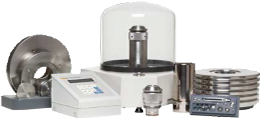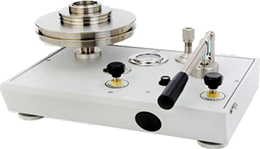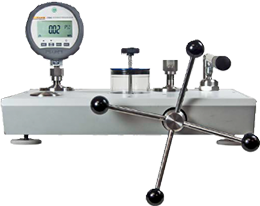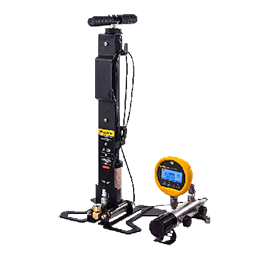Choosing the Right Pressure Standard Selection Guide
There are many different types of pressure standards available for performing pressure calibrations. Each of
these standards has its own unique benefits and drawbacks and thus each is appropriate for different
applications.
Choosing the right standard for the right calibration workload is essential to ensure the quality and
efficiency of your calibrations. This document explains the different types of pressure
standards available, what their benefits and drawbacks are, and provides example workloads.
The types of standards include:
- Piston gauges Deadweight testers
- Pressure controllers and calibrators
- Pressure comparators and digital pressure gauges
- Portable/handheld pressurecalibrators

Piston gauges
Piston gauges, also referred to as pressure balances and deadweight gauges, have been used for pressure
calibrations for decades. They are often referred to as fundamental or primary standards because they
determine pressure based on the fundamental equation P-F/A and are calibrated by determining the effective
area of the piston-cylinder.
The key benefits of a piston gauge are related to its accuracy. When used properly, a piston gauge can
provide very low uncertainties relative to the measured pressure (% reading). It is accurate enough to
calibrate almost any pressure device (within its pressure range) and can cover a very wide pressure range.
When properly maintained, piston gauges are very stable over time and will last for decades.
Piston gauges perform complex calculations to ensure that pressure is determined as accurately as possible.
Traditionally, these calculations were the responsibility of the operator and thus made piston gauges more
complex to use and more prone to errors. Modern piston gauges remove that complexity by performing the
calculations internally. Operator induced errors are further reduced when the piston gauge is fully
automated using optional accessories like the Automated Mass Handler (AMH).
Due to the precision machining required and their overall complexity, piston gauges are relatively expensive
to purchase compared to other types of pressure standards. This expense is offset by the fact that
recalibrations are often on longer intervals and their wide range coverage and low uncertainties result in
wider workload coverage. Piston gauge performance is impacted by the environmental factors. They can be used
in some unique portable applications, but are most commonly used in stationary setup.
Example workload items that a piston gauge can calibrate:
- Pressure controllers
- Deadweight testers
- Other piston gauges
- Portable/handheld pressure standards
- High accuracy barometers
- Air data test sets

Deadweight testers
Deadweight testers work on the same basic principles as piston gauges. The big difference is in the overall
accuracy level. Piston gauges include complex calculations and corrections to provide for the best possible
uncertainty. Deadweight testers allow for a number of assumptions, which make the deadweight tester easier
to use, but less accurate than a piston gauge.
Deadweight testers are preferred for many applications for some of the same reasons as piston gauges. They
can cover a wide pressure range, provide very stable pressures, and are very stable over time. They have a
lower price point than a piston gauge. Unfortunately, they are impacted by their environment and can be
heavy and awkward, making them unsuitable for many portable applications. Deadweight testers have been
replaced by pressure controllers and pressure comparators for many applications, but are still preferred for
their wide pressure range coverage and relatively good accuracy, especially for higher pressures using a
hydraulic media.
Example workload that a deadweight tester can calibrate:
- Other deadweight testers
- Digital gauges
- Analog gauges
- Pressure transmitters

Pressure controllers and calibrators
A pressure controller is a device that actively measures and controls the pressure in the test system. The overall uncertainties vary depending on the particular model, but most modern pressure controllers can cover a relatively wide pressure range, reaching a stable pressure quickly. Higher end pressure controllers have replaced piston gauges in some applications. Pressure controllers are simple to use and can be fully automated to improve overall efficiency and reproducibility of the calibrations. While most benchtop controllers are not very portable by nature, they can be installed on carts and used for some in-situ calibrations.
Pressure controllers have become very popular, especially for pneumatic calibrations for pressures of 21 MPa (3000 psi) and below. In this range they are very cost effective compared to deadweight testers. They are also popular for manufacturing applications because of their automation and fast control time. Pressure controllers are ideal for situations where high throughput is required.
More recent pressure controllers support multiple methods of full automation. They support remote communication through RS-232, GPIB, USB, and/or Ethernet ports. In addition, they will often times have built in programming tasks that allow for the automated execution of a series of pre-programmed pressure set points. Pressure calibrators that include electrical measurement capability, like the Fluke Calibration 2271A Industrial Pressure Calibrator, can perform a full closed-loop calibration by automating the control and measurement of pressure as well as the measurement and recording of the output of the device under test.
Example workload that a pressure controller or calibrator can calibrate:
- Digital test gauges
- Pressure transmitters
- Pressure transducers
- Dial gauges
- Pressure switches
- Portable calibrators
- Barometers
- Downhole tools

Pressure comparators and digital pressure gauges
Pressure comparators are devices that include all of the mechanical components necessary to generate and fine-tune a pressure. A pressure comparator has two test ports, one for the reference gauge and one for the device under test. A hydraulic comparator includes a fluid reservoir and screw press for generating and fine-tuning the pressure. It may also include a priming pump to simplify the initial generation of pressure. A pneumatic pressure comparator normally includes some sort of pump for generating pressure, a vent valve for releasing the pressure, and potentially means for fine tuning the pressure.
Wide pressure range coverage is accomplished by combining the comparator with different range reference gauges to handle different pressures. For example, a 70 MPa (10,000 psi) comparator may be used with a 70 MPa (10,000 psi), 20 MPa (3000 psi), and 7 MPa (1000 psi) gauges in order to support a wide range of test gauges.
Pressure comparators are relatively low cost and easy-to-use. The greatest challenge when using them is often related to pressure instability. A comparator inherently provides less stable pressure than a deadweight tester becauseit doesn’t have the floating piston to regulate the pressure. Certain steps can be taken in the design and usage of these instruments to reduce this issue, but if the application requires an extremely stable pressure than a traditional deadweight tester is the better choice.
Pressure comparators can often be firmly attached to a bench for permanent installations or taken in the field for in-situ calibrations. They are not as portable as handheld pumps, but are sufficiently portable for a variety of applications.
Example workload that a pressure comparator can calibrate:
- Dial gauges
- Pressure transmitters
- Pressure switches
- Relief valves

Portable/handheld pressure calibrators
Portable pressure calibrators take many different forms with different levels of capability. At the most basic level, they include some means of generating and measuring pressure and have a form factor that allows them to be used for in-situ calibrations. Pressure generation can be done through a manual pump, electric pump, or automated pressure control. Pressure measurement is achieved through built-in pressure sensors, external modules, or digital pressure gauges.
These portable devices are less accurate than other types of pressure standards but can normally handle wider environmental parameters (such as ambient temperature) without degrading performance. The design of the form factor puts a focus on their portability and field use, which may make them less efficient when used in permanently installed applications.
Example workload that a portable/handheld pressure calibrator can calibrate:
- Dial gauges
- Pressure transmitters
- Pressure switches
- Relief valves
Summary
There are many types of pressure standards, each with its own unique capabilities. To ensure the quality and efficiency of your calibrations, make sure you have the right standard for the job. Fluke Calibration provides each of these different types of standards and can assist you in finding the right one for your application.


 在线客服
在线客服